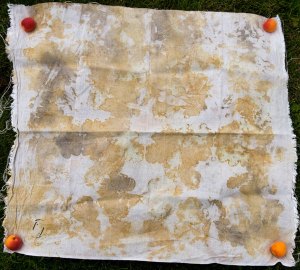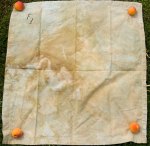At the moment when I plant dye I use the old recipes, the usual metal based mordants etc. to get some experience under my wings. But just because it’s done with plants, all these chemicals doesn’t also make it natural. “Wear a mask as you measure up the powder, gloves too”. In fact chrome, used in many recipes, is illegal here now for regular use, you can’t buy it. It can in fact alter your DNA!
 So to go all the way, I’d like to switch to natural mordants when possible (meaning that of course I’d still like to get the range of colours I’ve been discovering), so I’ll be doing a bit of research on that. I know India Flint does it, her book Eco Colour is very inspiring. The other day a fellow blogger introduced me to another one written specifically about using Native American plants and methods rather than
So to go all the way, I’d like to switch to natural mordants when possible (meaning that of course I’d still like to get the range of colours I’ve been discovering), so I’ll be doing a bit of research on that. I know India Flint does it, her book Eco Colour is very inspiring. The other day a fellow blogger introduced me to another one written specifically about using Native American plants and methods rather than
 transporting dyestuffs around the globe on planes that polute their way across the world. Melissa has done a book review and you can look inside it at Amazon, looks very nice. I know there are other books on the subject that I haven’t investigated yet (hints are welcome!! Comment section below is for feedback 😉 )
transporting dyestuffs around the globe on planes that polute their way across the world. Melissa has done a book review and you can look inside it at Amazon, looks very nice. I know there are other books on the subject that I haven’t investigated yet (hints are welcome!! Comment section below is for feedback 😉 )
 There’s also the question of all this boiling using electricity. So how about solar dyeing – does it really work as well, just takes longer, and who’s in such a hurry anyway? I see myself building a greenhouse not only for growing plants but with rows and rows of glass jars filled with colour and fiber…. A pretty sight inside my head at least. And of course using a campfire if you have pots that will stand up to that kind of thing, i.e. no plastic handles. I should start going to yard sales and look for copper and iron pots!
There’s also the question of all this boiling using electricity. So how about solar dyeing – does it really work as well, just takes longer, and who’s in such a hurry anyway? I see myself building a greenhouse not only for growing plants but with rows and rows of glass jars filled with colour and fiber…. A pretty sight inside my head at least. And of course using a campfire if you have pots that will stand up to that kind of thing, i.e. no plastic handles. I should start going to yard sales and look for copper and iron pots!
 So next year you’ll probably see me using different sources of tannin (how about that red wine which went sour?!), rhubarb leaves etc. I want to try spinning different cellulose fibers too, which require a different approach anyway. Can I use wood ash from our stove, which heats the house in winter? Is it really possible to lodge proteins in cotton cloth by soaking it in milk? Soy bean pulp? Fermenting?
So next year you’ll probably see me using different sources of tannin (how about that red wine which went sour?!), rhubarb leaves etc. I want to try spinning different cellulose fibers too, which require a different approach anyway. Can I use wood ash from our stove, which heats the house in winter? Is it really possible to lodge proteins in cotton cloth by soaking it in milk? Soy bean pulp? Fermenting?
På dansk
Miljøvenlig plantefarvning.
Bare fordi man bruger planter til at farve med, er det ikke nødvendigvis mere naturligt eller miljøvenligt. Vi bruger metaller som aluminium, jern, kobber og tin, importerer eksotisk bark og døde insekter fra den anden side af kloden osv.
Så jeg har tænkt mig på et tidspunkt, efterhånden som jeg får mere erfaring, at forsøge mig med andre metoder, bruge garvesyre fra the, agern, sur rødvin?!, rabarberblade, hjortetakbark og hvad man ellers kan finde. Især hvis man vil farve plantefibre som bomuld og hør skal der jo bejses på en lidt anden måde end ved proteinfibre – fx. har jeg læst at man kan lægge stof i mælk og få det til at optage proteinet og derved tage mere farve til sig på linie med uld. Tror det er India Flint som skriver det i Eco Colour.
Man kunne også begynde at gå på loppemarked efter kobber- og jerngryder som man kan bejse i over bål og derved spare på strømmen – måske ligefrem lave bålet af alt det ukrudt man går og hiver op af jorden hver sommer?!
Andre gode, skøre ideer eller viden er meget velkommen om emnet i kommentarsektionen – vær nu ikke så generte, de damer…. 😉

I recently learned about saving and reusing mordants, as well. Many people will save the pot of alum/water, and then the next time they need to mordant fiber, they just add 1/3 more alum to it. They swear it works. I figure that if I try doing it that way, I’ll never have to worry about how to dispose of my mordant. And I’ll save on the cost of the alum, too.
This is a great post to get us all thinking about how to be more eco-friendly in our dyeing. You would really enjoy Rebecca Burgess’ book called Harvesting Color. It is very eco-conscious.
Great, I’ll have a seious look at that book next time I shop!
I use my mordanting water over and over again, although I always add the same amount of alum and cream of tartar I would have used anyway. I’ve recently started doing cold mordanting too, so I add the mordants and the wool in a bucket, leave it overnight, then dye it the next day. It seems to work ok. I’ve heard from other dyers that cold mordanting works for them too, and they haven’t noticed any difference to the hot method.
Also on the topic of natural mordants, please do share your research and experiments, I’m really looking forward to hearing them! I recently read an article (in Finnish) about research someone had done on using willow as a natural mordant, apparently it works well but I’ve forgotten how much she recommend you need to use (I seem to remember you need twice the weight of your wool), so that’s definitely on my “to try” list now!
Heidi
Well I’m just about to do some mordanting tomorrow, so why not try the colder method for a change! Found some unknown flowers in the forest that I’ll try to dye with.
I have tried cold mordanting with alum and found it works well. I do a lot of dyeing weith eucalypts, which need no mordant (but then I didn’t see any growing in Denmark when I was there!) I have certainly used seawater followed by soymilk as a mordant on cellulose fabrics (hemp, linen, cotton) with success for India Flint’s eco-print technique. I’ll look forward to hearing more about your experiments.
More options to try! Great.
Eucalyptus don’t grow here no, I believe most of them are not winter hardy? I wonder if the few that are also have the dye properties…